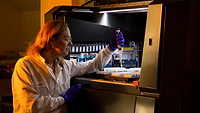Study Suggests Stratification and Increased, Smaller Samples can Improve Ability to Detect Cronobacter in Powdered Infant Formula

Image credit: PublicDomainPictures via Pixabay
A recent study conducted by researchers from the University of Illinois Urbana-Champaign concluded that, when sampling powdered infant formula for Cronobacter contamination, sampling with stratification may be more powerful than random sampling, and that taking more samples, even if smaller, increases the ability to detect contamination.
Cronobacter contamination of powdered infant formula has become an issue of increasing concern in recent years, following a 2022 foodborne illness outbreak that resulted in infant deaths, a massive recall, and a shortage of infant formula across the U.S. In November 2022, the U.S. Food and Drug Administration (FDA) released an outline of a prevention strategy that is under development to prevent C. sakazakii contamination of powdered infant formula. Additionally, in June 2023, the Council of State and Territorial Epidemiologists voted to add illnesses caused by C. sakazakii in powdered infant formula to the list of nationally notifiable diseases in the U.S.
Cronobacter in powdered infant formula can be difficult to detect because of low-level, heterogeneously distributed contamination. Established methods such as “hold and release” testing of final product can prevent highly contaminated products from going into markets; however, heterogeneously distributed, localized contamination can occur in powered products, thereby lowering the power of sampling plans.
Current Codex Alimentarius guidance for regulatory sampling plans for powdered infant formula are sample sizes equaling 30 and sample mass equaling 10 grams (g) for Cronobacter. Since each facility has different processing conditions and incoming ingredient qualities, it is important to evaluate sampling plans using realistic hazard contamination profiles to understand the power of sampling plans being used.
The present study aimed to test a simulation framework against infant formula powder production, which the authors state is a cost-effective, time-saving, and user-friendly approach to investigating sampling problems. Such a framework entails simulating different hazard profiles and sampling plans to characterize the efficacy of the plans by estimating the probability of a defined lot being accepted, under the assumption that a lot would be rejected if any Cronobacter is present (zero tolerance).
The researchers first benchmarked industry-relevant sampling plans across different numbers of grabs, total sample mass, and sampling patterns. Next, they evaluated detection performance against published Cronobacter contamination profiles for a recalled powdered infant formula batch with a 42 percent prevalence rate and −1.8 ± 0.7 log colony forming unit (CFU)/g concentration, as well as a non-recalled reference batch with 1 percent prevalence and −2.4 ± 0.8 log CFU/g concentration.
Different numbers of grabs and masses with the same total mass of 300 g—equivalent to the total mass of a Codex sampling plan for detecting Cronobacter in powdered infant formula—were simulated. Simulating grabs ranging 1–22,000, which represented testing every finished package, with 300 g total composite mass showed that taking 30 or more grabs detected contamination reliably. Benchmarking representative sampling plans—specifically, sample size of 30 and mass grab of 10 g, sample size of 30 and mass grab of 25 g, sample size of 60 and mass grab of 25 g, and sample size of 180 and mass grab of 25 g—showed that all plans would reject the recalled batch.
Overall, the researchers concluded that systematic or stratified random sampling patterns are equal to or more powerful than random sampling of the same sample size and total sampled mass, and that taking more samples, even if smaller, can increase the power to detect contamination.
Looking for a reprint of this article?
From high-res PDFs to custom plaques, order your copy today!






